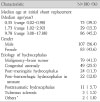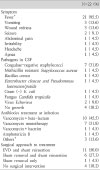Abstract
Purpose
Ventriculoperitoneal (VP) shunt insertion is an important treatment modality in children with hydrocephalus. VP shunt infection is a major complication and an important factor that determines the surgery outcome. This 15-year study was performed to evaluate the epidemiology of VP shunt infections in pediatric patients treated at our center.
Methods
A retrospective review of medical records was performed in patients 18 years old or younger who underwent VP shunt insertion surgery from April 1995 to June 2010.
Results
Three hundred twenty-seven VP shunt surgeries were performed in a total of 190 pediatric patients (83 females, 107 males). The median age of the patients was 2.4 years (range, 0.02-17.9 years). Having a malignant brain tumor was the most frequent cause for VP shunt insertion. The shunt infection rate was 6.7% (22/327) per 100 operations and 9.5% (18/190) per 100 patients, and the incidence rate was 0.45 infection cases per 100 shunt operations-year. The most common pathogen was coagulase-negative staphylococcus (n=7) followed by methicillin resistant Staphylococcus aureus (n=1). Ten cases were treated with vancomycin and beta-lactam antibiotic (cephalosporin or carbapenem) combination therapy and 7 cases were treated with vancomycin monotherapy. The median duration of antibiotic treatment was 26 days (range, 7 to 58 days). Surgical intervention was performed in 18 cases (18/22, 81.8%).
Figures and Tables
Table 3
Characteristics of Patients with Shunt Infections

Abbreviations : Pt, patient; meng, meningitis; cHCP, congenital hydrocephalus; recur, recurrent infection; cmHCP, communicating hydrocephalus; tSDH, traumatic subdural hemorrhage; HCP, hydrocephalus; MPS, mucopolysaccharide; hHCP, posthemorrhagic hydrocephalus; IVH, intraventricular hemorrhage in preterm infant; abd pain, abdominal pain; vanco, vancomycin; teico, teicoplanin; pi/tazo, piperacillin/tazobactam; EVD, external ventricular drain.
*The number of days after surgery that the symptoms began occurring.
References
1. Di Rocco C, Massimi L, Tamburrini G. Shunts vs endoscopic third ventriculostomy in infants: are there different types and/or rates of complications? A review. Childs Nerv Syst. 2006. 22:1573–1589.

2. Owen R, Pittman T. Delayed external ventriculoperitoneal shunt infection. J Ky Med Assoc. 2004. 102:349–352.
3. Chadduck W, Adametz J. Incidence of seizures in patients with myelomeningocele: a multifactorial analysis. Surg Neurol. 1988. 30:281–285.

4. Walters BC, Hoffman HJ, Hendrick EB, Humphreys RP. Cerebrospinal fluid shunt infection. Influences on initial management and subsequent outcome. J Neurosurg. 1984. 60:1014–1021.
5. Prusseit J, Simon M, von der Brelie C, Heep A, Molitor E, Volz S, et al. Epidemiology, prevention and management of ventriculoperitoneal shunt infections in children. Pediatr Neurosurg. 2009. 45:325–336.

6. Anderson EJ, Yogev R. A rational approach to the management of ventricular shunt infections. Pediatr Infect Dis J. 2005. 24:557–558.

7. Choux M, Genitori L, Lang D, Lena G. Shunt implantation: reducing the incidence of shunt infection. J Neurosurg. 1992. 77:875–880.

8. Key CB, Rothrock SG, Falk JL. Cerebrospinal fluid shunt complications: an emergency medicine perspective. Pediatr Emerg Care. 1995. 11:265–273.
9. Rowin ME, Patel VV, Christenson JC. Pediatric intensive care unit nosocomial infections: epidemiology, sources and solutions. Crit Care Clin. 2003. 19:473–487.
10. Conen A, Walti LN, Merlo A, Fluckiger U, Battegay M, Trampuz A. Characteristics and treatment outcome of cerebrospinal fluid shunt-associated infections in adults: a retrospective analysis over an 11-year period. Clin Infect Dis. 2008. 47:73–82.

11. James HE, Walsh JW, Wilson HD, Connor JD. The management of cerebrospinal fluid shunt infections: a clinical experience. Acta Neurochir (Wien). 1981. 59:157–166.
12. James HE, Walsh JW, Wilson HD, Connor JD, Bean JR, Tibbs PA. Prospective randomized study of therapy in cerebrospinal fluid shunt infection. Neurosurgery. 1980. 7:459–463.

13. Schreffler RT, Schreffler AJ, Wittler RR. Treatment of cerebrospinal fluid shunt infections: a decision analysis. Pediatr Infect Dis J. 2002. 21:632–636.

14. Tunkel AR, Hartman BJ, Kaplan SL, Kaufman BA, Roos KL, Scheld WM, et al. Practice guidelines for the management of bacterial meningitis. Clin Infect Dis. 2004. 39:1267–1284.

15. Whitehead WE, Kestle JR. The treatment of cerebrospinal fluid shunt infections. Results from a practice survey of the American Society of Pediatric Neurosurgeons. Pediatr Neurosurg. 2001. 35:205–210.

16. McClinton D, Carraccio C, Englander R. Predictors of ventriculoperitoneal shunt pathology. Pediatr Infect Dis J. 2001. 20:593–597.

17. McGirt MJ, Zaas A, Fuchs HE, George TM, Kaye K, Sexton DJ. Risk factors for pediatric ventriculoperitoneal shunt infection and predictors of infectious pathogens. Clin Infect Dis. 2003. 36:858–862.

18. Reddy GK. Ventriculoperitoneal shunt surgery and the incidence of shunt revision in adult patients with hemorrhage-related hydrocephalus. Clin Neurol Neurosurg. 2012. 114:1211–1216.

19. Garner JS, Jarvis WR, Emori TG, Horan TC, Hughes JM. CDC definitions for nosocomial infections 1988. Z Arztl Fortbild (Jena). 1991. 85:818–827.

20. Horan TC, Andrus M, Dudeck MA. CDC/NHSN surveillance definition of health care-associated infection and criteria for specific types of infections in the acute care setting. Am J Infect Control. 2008. 36:309–332.

21. Bokhary MA, Kamal H. Ventriculo-peritoneal shunt infections in infants and children. Libyan J Med. 2008. 3:20–22.

23. Braga MH, Carvalho GT, Brandão RA, Lima FB, Costa BS. Early shunt complications in 46 children with hydrocephalus. Arq Neuropsiquiatr. 2009. 67:273–277.

24. Enger PØ, Svendsen F, Sommerfelt K, Wester K. Shunt revisions in children--can they be avoided? Experiences from a population-based study. Pediatr Neurosurg. 2005. 41:300–304.
25. Kontny U, Höfling B, Gutjahr P, Voth D, Schwarz M, Schmitt HJ. CSF shunt infections in children. Infection. 1993. 21:89–92.

26. Mancao M, Miller C, Cochrane B, Hoff C, Sauter K, Weber E. Cerebrospinal fluid shunt infections in infants and children in Mobile, Alabama. Acta Paediatr. 1998. 87:667–670.

27. Odio C, McCracken GH Jr, Nelson JD. CSF shunt infections in pediatrics. A seven-year experience. Am J Dis Child. 1984. 138:1103–1108.
28. Stevens NT, Greene CM, O'Gara JP, Bayston R, Sattar MT, Farrell M, et al. Ventriculoperitoneal shunt-related infections caused by Staphylococcus epidermidis: pathogenesis and implications for treatment. Br J Neurosurg. 2012. 26:792–797.

29. Olson ME, Slater SR, Rupp ME, Fey PD. Rifampicin enhances activity of daptomycin and vancomycin against both a polysaccharide intercellular adhesin (PIA)-dependent and -independent Staphylococcus epidermidis biofilm. J Antimicrob Chemother. 2010. 65:2164–2171.

30. Silva LV, Araújo MT, Santos KR, Nunes AP. Evaluation of the synergistic potential of vancomycin combined with other antimicrobial agents against methicillin-resistant Staphylococcus aureus and coagulase-negative Staphylococcus spp strains. Mem Inst Oswaldo Cruz. 2011. 106:44–50.





 PDF
PDF ePub
ePub Citation
Citation Print
Print




 XML Download
XML Download